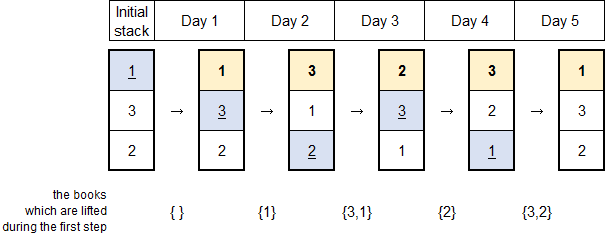【Good Bye 2014C】【脑洞】New Year Book Reading 书放一摞依次看 最佳顺序使费用最小
来源:互联网 发布:背身护球 知乎 编辑:程序博客网 时间:2024/06/06 21:06
New Year is coming, and Jaehyun decided to read many books during 2015, unlike this year. He has n books numbered by integers from 1 to n. The weight of the i-th (1 ≤ i ≤ n) book is wi.
As Jaehyun's house is not large enough to have a bookshelf, he keeps the n books by stacking them vertically. When he wants to read a certain book x, he follows the steps described below.
- He lifts all the books above book x.
- He pushes book x out of the stack.
- He puts down the lifted books without changing their order.
- After reading book x, he puts book x on the top of the stack.

He decided to read books for m days. In the j-th (1 ≤ j ≤ m) day, he will read the book that is numbered with integer bj (1 ≤ bj ≤ n). To read the book, he has to use the process described in the paragraph above. It is possible that he decides to re-read the same book several times.
After making this plan, he realized that the total weight of books he should lift during m days would be too heavy. So, he decided to change the order of the stacked books before the New Year comes, and minimize the total weight. You may assume that books can be stacked in any possible order. Note that book that he is going to read on certain step isn't considered as lifted on that step. Can you help him?
The first line contains two space-separated integers n (2 ≤ n ≤ 500) and m (1 ≤ m ≤ 1000) — the number of books, and the number of days for which Jaehyun would read books.
The second line contains n space-separated integers w1, w2, ..., wn (1 ≤ wi ≤ 100) — the weight of each book.
The third line contains m space separated integers b1, b2, ..., bm (1 ≤ bj ≤ n) — the order of books that he would read. Note that he can read the same book more than once.
Print the minimum total weight of books he should lift, which can be achieved by rearranging the order of stacked books.
3 51 2 31 3 2 3 1
12
Here's a picture depicting the example. Each vertical column presents the stacked books.

#include<stdio.h>#include<iostream>#include<string.h>#include<string>#include<ctype.h>#include<math.h>#include<set>#include<map>#include<vector>#include<queue>#include<bitset>#include<algorithm>#include<time.h>using namespace std;void fre() { freopen("c://test//input.in", "r", stdin); freopen("c://test//output.out", "w", stdout); }#define MS(x,y) memset(x,y,sizeof(x))#define MC(x,y) memcpy(x,y,sizeof(x))#define MP(x,y) make_pair(x,y)#define ls o<<1#define rs o<<1|1typedef long long LL;typedef unsigned long long UL;typedef unsigned int UI;template <class T1, class T2>inline void gmax(T1 &a, T2 b) { if (b>a)a = b; }template <class T1, class T2>inline void gmin(T1 &a, T2 b) { if (b<a)a = b; }const int N = 505, M = 0, Z = 1e9 + 7, ms63 = 0x3f3f3f3f;int n, m;int w[N];int b[N];int main(){while (~scanf("%d%d", &n,&m)){for (int i = 1; i <= n; ++i)scanf("%d", &w[i]);int bot = 0;int ans = 0;for (int i = 1; i <= m; ++i){int r; scanf("%d", &r);bool flag = 0;for (int j = 1; j <= bot; ++j){if (b[j] == r){flag = 1;for (int k = j; k >= 1; --k)b[k] = b[k - 1];b[1] = r;break;}ans += w[b[j]];}if (!flag) {++bot;for (int k = bot; k >= 1; --k)b[k] = b[k - 1];b[1] = r;}}printf("%d\n", ans);}return 0;}/*【trick&&吐槽】最大的答案可能是n*m*100=5e7,int足以。【题意】有n(500)本书,成一摞。我们有一个看书的顺序。要看第i本书的时候,我们要——1,把这本书之上的书搬走,体力成本加上这本书之上的书的重量之和,再放回之上的所有书(不改变顺序);2,看这本书,把这本书放在最上面。问你初始的书从上到下的顺序可以是怎么样,能够使得我们的体力成本最小【类型】脑洞【分析】显然,我们书的初始摆放顺序就按照我们看书的顺序就好了。否则,我们还要浪费多余成本的调整成这个样子。于是按照这个原则贪心下去就可以得到最优解。【时间复杂度&&优化】O(nm)*/- 【Good Bye 2014C】【脑洞】New Year Book Reading 书放一摞依次看 最佳顺序使费用最小
- CF~Good Bye 2014 C. New Year Book Reading
- Good Bye 2014 C. New Year Book Reading 贪心
- C. New Year Book Reading
- C. New Year Book Reading
- Good Bye 2014 E. New Year Domino
- Good Bye 2014--A. New Year Transportation
- Good Bye 2014--B. New Year Permutation
- Good Bye 2014 B. New Year Permutation
- New Year Book Reading
- Codeforces 500C New Year Book Reading
- Codeforces 500C New Year Book Reading
- CF 500C New Year Book Reading
- codeforces 500C New Year Book Reading
- CodeForces 500C New Year Book Reading
- C. New Year Book Reading codeforces
- Codeforce 500c New Year Book Reading
- Codeforces Good Bye 2015 C. New Year and Domino (预处理)
- LinkedList其实就那么一回事儿之源码浅析
- 【Good Bye 2014B】【Floyd or 并查集】New Year Permutation 全排列有位置交换序列 使得字典序尽可能小
- Laravel 调试利器 —— Laravel Debugbar 扩展包安装及使用教程(转)
- CodeForces 452C - Magic Trick-概率
- 日经春秋 20160321
- 【Good Bye 2014C】【脑洞】New Year Book Reading 书放一摞依次看 最佳顺序使费用最小
- PTA基础编程 5-15 计算圆周率 (15分)
- Java排序算法(一)--快速排序(QuickSort)
- 【Good Bye 2014D】【期望的线性可加 基本元素累计】New Year Santa Network 树上取3点,路径权值之和的期望
- sql的case语句
- #38. 【清华集训2014】奇数国|线段树|欧拉函数
- error at ::0 can't find referenced pointcut解决办法
- 【Good Bye 2014E】【贪心 单调栈+线段树】New Year Domino 至少增加多高长度的多米诺骨牌才可推x倒y
- ABAP改表狂魔程序


